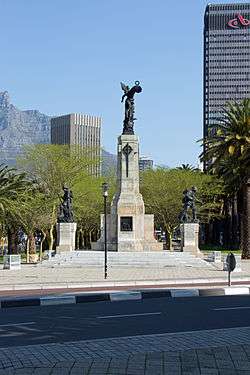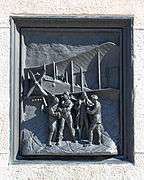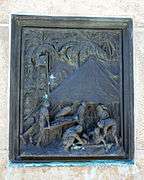The Cenotaph, Cape Town
| The Cenotaph | |
|---|---|
| South Africa | |
 | |
| For soldiers who died in World War I, World War II and the Korean War | |
| Unveiled | 3 August 1924 |
| Location |
33°55′08″S 18°25′36″E / 33.918795°S 18.426623°ECoordinates: 33°55′08″S 18°25′36″E / 33.918795°S 18.426623°E Cape Town |
| Designed by | Vernon March |
|
To the immortal honour of the South Africans who made the supreme sacrifice in the Great War This memorial is dedicated in proud and grateful recognition by their countrymen Sea and Air Their name liveth for evermore 1914–1918 The Second world war 1939–1945 The Korean war 1950–1953 | |

The Cenotaph on Heerengracht Street in Cape Town is the city's main war memorial where annual Remembrance Day ceremonies are held.[1][2][3] It is classified as a public memorial and as such is subject to protection in terms of heritage legislation administered by Heritage Western Cape, the provincial heritage resources authority of the Western Cape province of South Africa.[4]
Purpose
First unveiled in 1924 to commemorate soldiers who died in World War I, it also commemorates soldiers who subsequently died in World War II and the Korean War.[2][5] The City of Cape Town holds Remembrance Day ceremonies at the Cenotaph annually at 11am on the Sunday closest to 11 November.[6][7][8] The wreath laying ceremonies include the wearing of red remembrance poppies,[6] the "Last Post" bugle call and the observation of a two-minute silence.[3][8][9]
The Cenotaph was unveiled on 3 August 1924 by South Africa's then Governor-General Alexander Cambridge, 1st Earl of Athlone,[2] who said:[1][3]
I cannot but believe that the existence of these visible memorials, which are to be found throughout the world – silent witnesses to the desolation of the war – will through the years to come, be potent advocates of peace and will eventually serve to draw all peoples together in mutual understanding.
Design
The memorial was designed by English sculptor Vernon March and comprises two bronze figures of soldiers in action on separate sandstone columns, one on either side of a tall central sandstone column supporting a bronze winged victory figure.[2][5] One of the flanking soldier figures depicts South Africans in World War I who fought in the East African Campaign and the other depicts those who fought in the Western Front.[2][3] The winged victory figure, modelled on the Winged Victory of Samothrace, faces Table Mountain holding a laurel wreath high and treading on a serpent wrapped around a globe.[1][2][3][5] The central column, decorated with bronze wreathed swords at the top, stands 8 metres (26 ft) tall. Four bronze plaques at its base depict various battle scenes, including a trench scene of the Battle of Delville Wood, an artillery scene, an aircraft scene and a hospital scene.[3] Inscriptions on the memorial are written in English and Afrikaans.[2] The memorial stands on a square granite base.[5]
The design of the memorial is similar to that of the Diamond War Memorial erected in Derry, Northern Ireland in 1927, which was also designed by March.[10][11]
| Plaques at the base of the Cenotaph | ||||||||
|---|---|---|---|---|---|---|---|---|
|
Location
The Cenotaph is located on the Heerengracht Street median at the street's intersection with Herzog Boulevard in Cape Town's city centre, on the city's main boulevard.[5][12][13] It has been relocated twice to facilitate development of the city's transport infrastructure, in 1959 and 2013.[2][5] It was first erected at the bottom of Adderley Street in 1924.[1] In 1959 it was moved by 8 metres (26 ft) when Adderley Street was widened.[2][3] In 2013 it was moved again by 300 metres (980 ft),[12] from Adderley Street's central island at the intersection of Riebeek Street opposite the Cape Town railway station to the Heerengracht Street median on the same axis of the city,[2][7] to make way for a new feeder station for the MyCiTi bus rapid transit system.[14][15][16]
See also
References
- 1 2 3 4 Bickford-Smith, Vivian; van Heyningen, Elizabeth; Worden, Nigel (1999). Cape Town in the Twentieth Century: An Illustrated Social History. New Africa Books. p. 75. ISBN 9780864863843. Retrieved 2 August 2014.
- 1 2 3 4 5 6 7 8 9 10 O'Donoghue, Bridget (March 2009). "Audit of Sculptures, Memorials and Monuments – 2.B.14 The Cenotaph War Memorial" (PDF). pp. 80–84,142. Retrieved 3 August 2014.
- 1 2 3 4 5 6 7 Binckes, Helen Euphrosyne Constance (2010). South African public memorials of World War One. A historical view of processes in public memorialisation through their symbolic content, with particular reference to Cape Town. (PDF) (M.A.). University of Cape Town. pp. 127–137.
- ↑ Section 37, National Heritage Resources Act, Act 25 of 1999, Government Notice 502, South African Government Gazette, vol 406, No. 19974 of 28 April 1999
- 1 2 3 4 5 6 "Cenotaph war memorial restored in time for Remembrance Day". City of Cape Town. 28 October 2013. Archived from the original on 2 August 2014. Retrieved 2 August 2014.
- 1 2 Helfrich, Kim (10 November 2011). "Red poppies for remembrance". The New Age. Archived from the original on 3 August 2014. Retrieved 3 August 2014.
- 1 2 Helfrich, Kim (9 May 2012). "'Makes sense' to move Cape Town's cenotaph". The New Age. Archived from the original on 2 August 2014. Retrieved 2 August 2014.
- 1 2 Majiet, Laila (11 November 2013). "Honouring fallen heroes". People's Post. Archived from the original on 3 August 2014. Retrieved 3 August 2014.
- ↑ "Fallen war heroes honoured on Remembrance Day". SABC News. 11 November 2012. Archived from the original on 3 August 2014. Retrieved 3 August 2014.
- ↑ Baker, Eamonn (17 July 2008). "Memorial to a celebrated sculptor". Derry Journal. Archived from the original on 3 August 2014. Retrieved 3 August 2014.
- ↑ "The truth behind The Diamond War Memorial". Londonderry Sentinel. 16 November 2011. Archived from the original on 8 August 2014. Retrieved 8 August 2014.
- 1 2 "Adderley Street cenotaph begins move to new home". Cape Argus. 9 July 2013. Archived from the original on 2 August 2014. Retrieved 2 August 2014.
- ↑ Knoetze, Daneel (13 March 2012). "Moving Cenotaph an appalling idea – historian". Cape Argus. Archived from the original on 2 August 2014. Retrieved 2 August 2014.
- ↑ Knoetze, Daneel (12 March 2012). "The Cenotaph is on the move". Cape Argus. Archived from the original on 2 August 2014. Retrieved 2 August 2014.
- ↑ Felix, Jason (22 July 2013). "Tough task to move war statue". Cape Times. Archived from the original on 2 August 2014. Retrieved 2 August 2014.
- ↑ "Cenotaph settles in". People's Post. 26 October 2013. Archived from the original on 2 August 2014. Retrieved 2 August 2014.
Further reading
- O'Donoghue, Bridget (February 2012). "Heritage Statement: Reconstruction of the Cenotaph on Grand Parade Cape Town" (PDF). Retrieved 2 August 2014.
- O'Donoghue, Bridget (April 2012). "Heritage Impact Assessment: Proposed Relocation of the Cenotaph for the IRT Bus Station Adderley Street Cape Town" (PDF). Retrieved 3 August 2014.
- Abrahamse, Claire (September 2013). "Cape Town Station Forecourt Precinct Phase 1 Heritage Impact Assessment" (PDF). Retrieved 5 August 2014.
External links
| Wikimedia Commons has media related to Cenotaph, Cape Town. |



